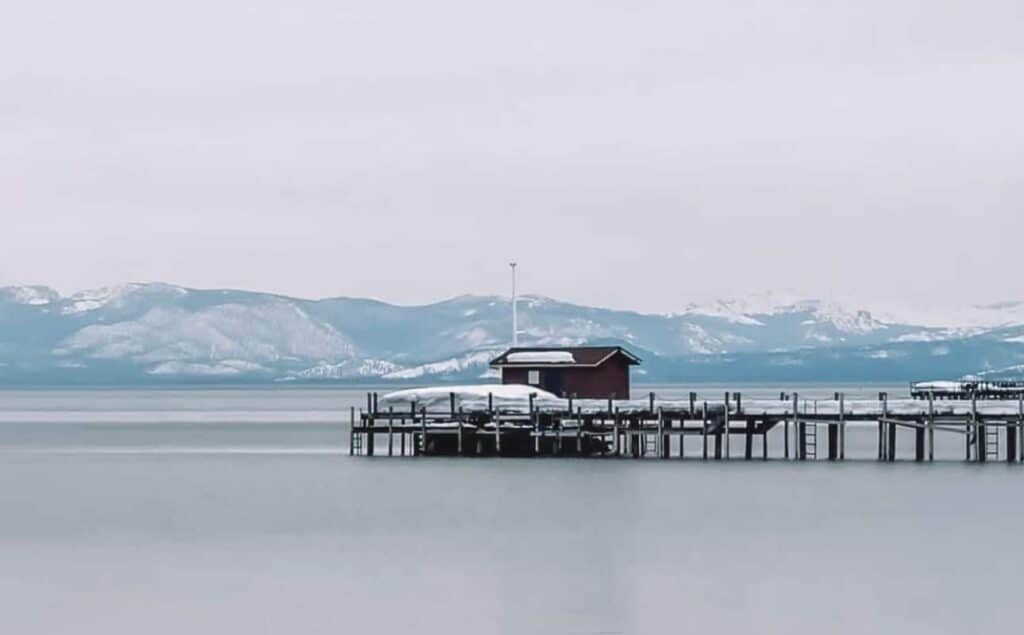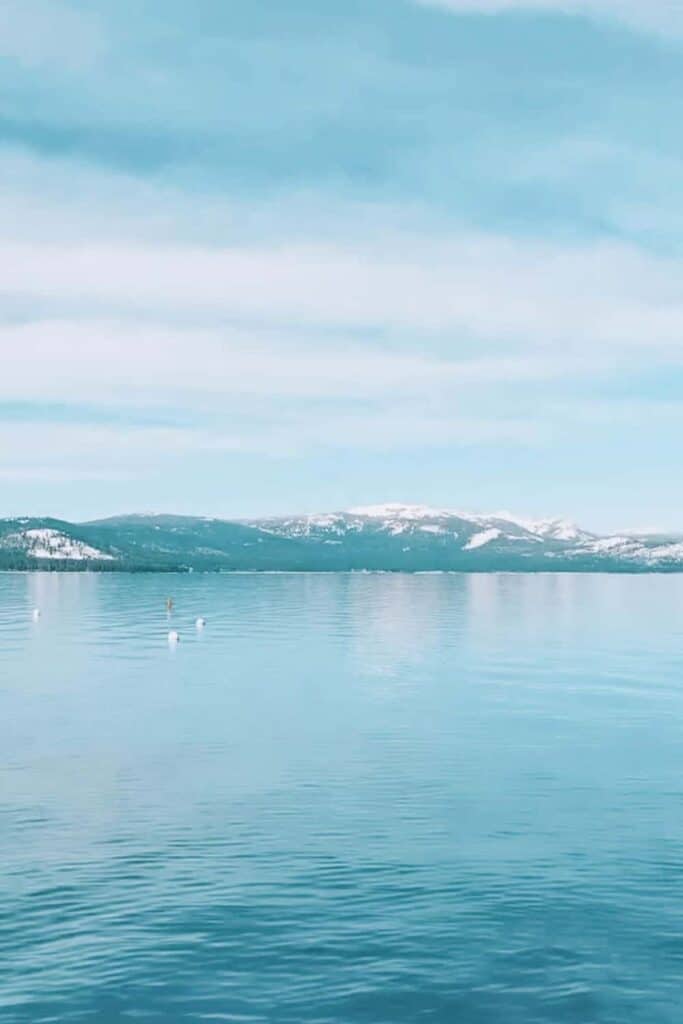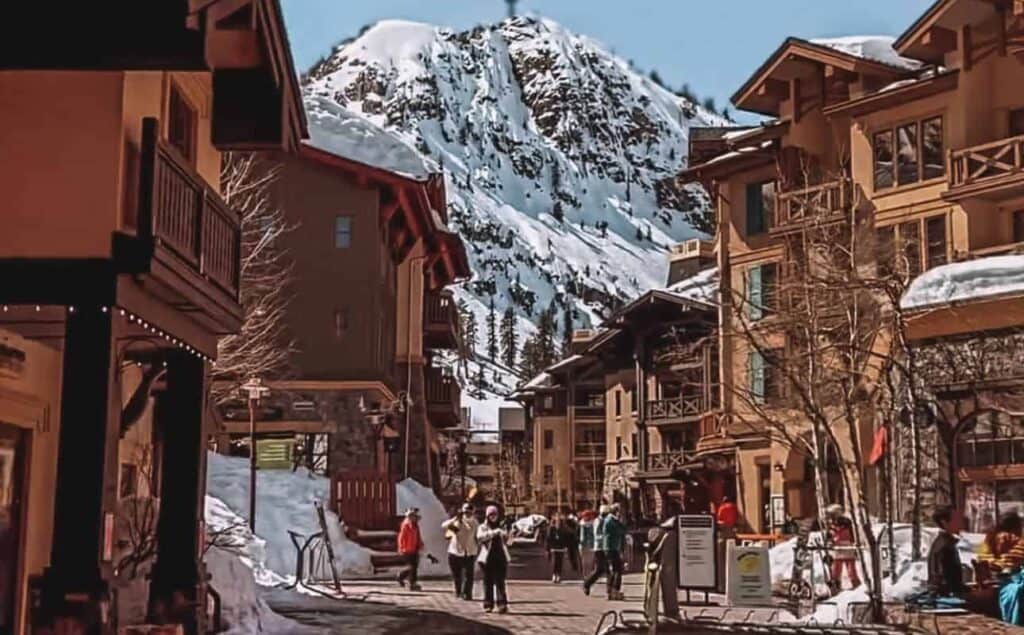Lake Tahoe Elevation: Everything You Need To Know To Have The Best Trip
Are you looking for the best guide on Lake Tahoe elevation? You’ve found it! Eric and I absolutely love traveling to the USA and Lake Tahoe is one of the most romantic destinations in California, one that a lot of couples choose to elope to because of its natural beauty and large offer of activities. So we had to write a guide about how you can best handle the elevation of Lake Tahoe CA so you can have the best experience there.
Eric, having grown up in Vancouver, knows all about mountains, elevation and altitude sickness. Lake Tahoe is known as the crown jewel of the Sierra Nevada Mountains and while it attracted millions of visitors, both foreigners and locals, every year, it is also known for its high elevation and the difficulties or sickness it can cause in some people.
In this guide, we gathered all of our hiking and mountain experience from all over the world to share all of our tips about symptoms of elevation Tahoe may cause along with how to best adjust to the elevation at Lake Tahoe and of course, what is the Lake Tahoe altitude! After all, it would be a shame to ruin your time at Tahoe hot springs just because of the altitude. The Lake Tahoe region is wonderful, especially during spring, so read our guide to make sure you can enjoy your trip to the fullest regardless of the altitude you’re at!

What is the Lake Tahoe elevation
What is the elevation of Lake Tahoe? That’s the question we’re all longing to get an answer for! In this section, we share the Lake Tahoe elevation in feet and the Lake Tahoe altitude meters. Note that when we’re taking about the Lake Tahoe elevation, we essentially mean the Lake Tahoe height.
What elevation is Lake Tahoe?
The Lake Tahoe elevation is 6,225 feet (1,900 meters) above sea level, the sea level being point 0.
- Lake Tahoe elevation feet: 6,225 (called the natural rim)
- Lake Tahoe elevation meters: 1,900
Now, this is the elevation for the surface of Lake Tahoe but there are points in Lake Tahoe that go way higher. For example some surrounding mountain peaks reach 9,000 to 11,000 feet.
What is South Lake Tahoe elevation?
The elevation of South Lake Tahoe CA is 6,237feet (1,901 meters) which is slightly higher than Lake Tahoe’s surface elevation. South Lake Tahoe is actually at the 8th highest elevation with a population of over 20,000 people in the USA.
North Lake Tahoe elevation
The elevation for North Lake Tahoe (around Kings Beach and Incline Village) is 6,237 feet (1,901 meters) as well.
Lake Tahoe City elevation
Lake Tahoe City is at the same elevation as Lake Tahoe which is 6,225 feet and 1,900 meters.
Hotel elevation Lake Tahoe
The resort of Heavenly Lake Tahoe elevation is 6,255 feet (1,907 meters) at the base. The Heavenly ski resort elevation at the top is 10,067 feet (3,068 meters).
Sierra at Tahoe elevation
The Sierra at Tahoe Resort elevation is 6,640 feet (2,024 meters) at the base and 8,852 feet (2,698 meters) at the top.
How to adjust to Lake Tahoe’s altitude
Regardless of what you’re going to be doing in Lake Tahoe, it’s a good idea to prepare for Tahoe Lake elevation. As a rule of thumb, the higher the altitude in Tahoe, the lower the oxygen levels are. But don’t worry, thousands of people visit Lake Tahoe every year and most people don’t even feel the effects of Lake Tahoe elevation.
Regardless, it’s good to know how to easily adjust to Lake Tahoe’s altitude in case you start feeling some symptoms. Note that Eric grew up in British Columbia where there are lots of mountains and the altitude can also sometimes get to you. So in this section, we give you some tips on how to best adjust to the elevation in Lake Tahoe but also in general!
- Prepare: Nothing beats preparation! Once you know that the elevation in Lake Tahoe can affect you, you’re ready to prepare for it. By being prepared, we mean doing a range of things.
- First, you can start hiking in the mountains a few weeks before to see if the altitude affects you at all. Though your mountains will probably be lower than Lake Tahoe, it’s a good way to slowly get acclimated to lower levels of oxygen.
- Second, you can prepare by checking that you don’t have any health issues that could get worse due to lower levels of altitude. Things like asthma can cause trouble so a quick check up at the doctor if you have any doubt is always a good idea.
- Finally, plan you trip in a way that you’re not constantly doing physical activities in Tahoe. That will give you time to rest and moments for your body to rest and readjust.
- Go slow: If you’re not a big hiker and decided to go see the beauty of Tahoe from up there on a whim, make sure you go slow as you go up. This will give your body plenty of time to adjust. Go slow also if you decide to go spring skiing in Tahoe and make sure to adjust to the altitude first.
- Stay hydrated: Drinking water is recommend to get acclimatised to altitude. It is recommended to drink 3 to 4 quarts of water per day. You can start before getting to Lake Tahoe so your body has time to adjust. Because of the lower levels of oxygen, your body needs to be given more water. Note also that with altitude comes dryer air so staying hydrated is essential.
- Relax and take it easy: Lake Tahoe is a great place for all sorts of physical activity like cycling, hiking and walking. However, it’s also a great place to relax. For example, Lake Tahoe is home to quite a few natural hot springs. These natural hot springs are the perfect place to relax while giving you a break from the altitude.
- Eat carbohydrates: Another common recommendation to adjust to Lake Tahoe elevation is to eat carbohydrates. Carbs provide energy to your body which it will need to compensate the lower levels of oxygen! Anything like bread and pasta is good, and even better if it’s wholemeal!
- Avoid alcoholic drinks: It’s common knowledge that alcohol can make any symptoms worse. If you’re having a hard time adjusting to the altitude or are anxious about adjusting to it, avoid drinking alcohol before and during your trip to Tahoe.
- Other tips from the NHS, to adjust to the high altitude similar to the Lake Tahoe elevation, include to avoid flying directly to the high altitude area so your body can have time to adjust slowly, avoid smoking, and have a light but high-calorie diet. The NHS also recommends avoiding any strenuous activity in the first two to three days.
- If your trip to Lake Tahoe involves bringing a date to go hiking, we highly recommend checking with them first if this is something they feel is appropriate for them. You don’t want a hike with a first date to turn into a catastrophe because of high elevation symptoms!

Lake Tahoe elevation and hiking
Lake Tahoe is a haven for hiking enthusiasts. The lake offers many trails right on the lake or higher in the mountains. But with high altitude can come certain difficulties for hikers. Here’s what to expect when hiking at Lake Tahoe.
What to expect when hiking at Lake Tahoe’s altitude
Lake Tahoe itself is only located at 6,237 feet (1,901 meters). However, even though certain trails start at the Lake, they go up into the mountains where the levels of oxygen are much lower. This means that starting a hike might feel easy until it’s not. For example, the highest point on the Tahoe Rim Trail elevation profile is Relay Peak at 10,286 feet (3,135 meters)
Lake Tahoe is estimated to provide 20% less oxygen than you would get at sea level which makes quite a difference. It’s not as much as some of the other peaks though. For example, at Monument Peak, it’s estimated that the levels of oxygen are 36.6% lower than at sea level.
How to hike in Lake Tahoe
When going hiking in Lake Tahoe, make sure you are prepared and realistic. If you are a Sunday hiker, don’t get yourself into long and strenuous hikes with a high elevation. Staying around the lake on shorter hikes will be just as beautiful and less difficult to deal with.
If you do embark on high elevation hikes, make sure to go slow. High elevation hikers often recommend to take breaks at different altitudes so your body can adjust.
Note also that the weather can drastically change in Lake Tahoe depending on the season. You won’t feel the same symptoms when it’s freezing outside than when it’s burning hot. Make sure to know your body and to not push it beyond its limit, especially if you’re here to relax on vacation! Don’t forget, in any cases to share your hiking experience on social media with one of our California captions.
Does drinking alcohol make Lake Tahoe elevation worse?
According to the FAA Civil Aeromedical Institute, the difference in the decrease of cognitive function between individuals who had alcohol at sea level and individuals who ad it at 12,000 feet was very small. This was also found in a study by Collins, Mertens and Higgins in 1987.
So even though it is common thinking that drinking alcohol at an altitude makes you more intoxicated or emphasises your symptoms, scientific studies show that drinking alcohol at sea level or at a high altitude doesn’t affect the body differently in terms of intoxication levels.
However, the dizziness feeling that some people get is mostly explained by the lower levels of oxygen available at a high altitude and how that interacts with the alcohol consumption. Note also that because your body is getting less oxygen and humidity levels are lower, your body will process alcohol slower and with more difficulty which can cause dizziness.
Can you get Lake Tahoe altitude sickness?
The elevation at South Lake Tahoe and North Lake Tahoe can cause altitude sickness. This altitude sickness is also known as mountain sickness. It’s a set of symptoms that are caused by the lower levels of available oxygen associated with the dryer air and lack of humidity.
According to the Cleveland Clinic, a high number of people will experience mountain sickness when traveling to a high elevation. A high elevation is any altitude of 8,000 feet or above. Lake Tahoe sits at just over 6,000 feet so the symptoms, if any, will be mild. The clinic states that about 50% of people will get mild altitude sickness symptoms at around 8,000 feet while 75% will get the same symptoms at 10,000 feet.
Symptoms of altitude sickness Lake Tahoe can cause
According to the UK National Health Society, a high elevation similar to the elevation in Lake Tahoe can cause the following symptoms:
- headache
- shortness of breath
- dizziness
- fatigue
- sleeping issues
- loss of appetite
- nausea
- vomiting
These symptoms are common and, according to the NHS, can develop between 6 and 24 hours after reaching the high altitude (anything above 2,500 meters/8,202 feet)
HAPE (High-Altitude Pulmonary Edema) and HACE (High-Altitude Cerebral Edema) are more severe symptoms of altitude sickness but also more rare.
Quick Lake Tahoe facts
In this section, Eric and I wanted to share some facts about Lake Tahoe surface elevation that we found particularly interesting, and some, a bit scary!
Location of Lake Tahoe
Lake Tahoe, also known as the Tahoe Basin, is a freshwater lake located in the Sierra Nevada Mountains, on the border between California and Nevada. It is one of the largest and deepest lakes in the United States and is a popular year-round destination for outdoor enthusiasts and nature lovers. It’s surrounded by large cities such as South Lake Tahoe, and Carson and by State Parks such as Burton Creek State Park and Lake Tahoe Nevada State Park. The coordinates of the geographic centre of the main body of Lake Tahoe are 39° 06’ 30” N and 120° 01’ 51” W.
Age of Lake Tahoe
One of the most remarkable facts about Lake Tahoe is its age. Scientists estimate that Lake Tahoe was formed around 2 to 3 million years ago. The lake was created by a series of geological events that caused the surrounding mountains to rise and fall along a system of north-south trending faults. As a result, the basin that contained the lake gradually formed over time and turned int the lake we now know. We think it’s pretty incredible how Lake Tahoe started from nothing and has become one of the largest alpine lakes in the USA!
Lake Tahoe depth, one of the scary facts about Lake Tahoe
The depth of Lake Tahoe is another fascinating aspect of this wonder of nature. The lake’s average depth is around 1,000 feet (305 meters), making it the second-deepest lake in the United States, after Oregon’s Crater Lake. The maximum depth of Lake Tahoe is over 1,600 feet (490 meters) in Crystal Bay, making it one of the deepest lakes in the world.
Lake Tahoe surface area
In terms of surface area, Lake Tahoe covers an impressive 191 square miles (122,200 acres). The lake has a length of approximately 22 miles (35 kilometers) and a width of around 12 miles (20 kilometers). The shoreline of Lake Tahoe is approximately 75 miles (120 kilometers) long.
Lake Tahoe water level and volume of water
Despite its great depth, Lake Tahoe holds an enormous volume of water. It contains around 39 trillion gallons (148 trillion litres) of water, making it the largest alpine lake in North America. However, despite its large volume, the water levels in Lake Tahoe fluctuate throughout the year. The volume of water and lake level are regulated by the dam at Tahoe City. The lake is fed by snowmelt and rain, and its water levels can rise or fall depending on the season.
Direction of the water and water clarity
The water in Lake Tahoe flows in a southward direction, from its outlet at Tahoe City, into the Truckee River, which eventually empties into Pyramid Lake, Nevada. The water clarity of Lake Tahoe is also noteworthy. The lake is known for its clear, blue waters, which have a transparency of up to 75 feet (23 meters) in some areas. The clarity of the water is due to the fact that the lake is fed by over 60 tributaries, which bring in water that is naturally filtered by the surrounding granite rock.
Quick historical facts about Lake Tahoe
- In 1861, Mark Twain (who is also a fan of the hot springs near Lake Tahoe) hiked 12 miles from Carson City, Nevada to Lake Tahoe while looking for a timber claim. He camped on the North Shore and accidentally started a wildfire.
- In 1960, Squaw Valley on the West Shore of Lake Tahoe welcomed the Olympic Winter Games.

Does Lake Tahoe ever freeze?
While Lake Tahoe is a freshwater lake, it does occasionally freeze over. However, this usually only occurs during very cold winters. The last time the lake completely froze over was in March 2023, which had not happened since the 1990s! The freeze happened in the Emerald Bay section of Lake Tahoe.
In summary, Lake Tahoe is a unique and stunning natural wonder with many fascinating facts. Its age, depth, surface area, volume of water, water levels, direction of the water, and water clarity make it a lovely and interesting destination for both visitors and locals. While it may be best known for its outdoor recreation opportunities, such as skiing, hiking, and boating, the lake’s sheer size and beauty are enough reasons to visit all year-round!
Best time to visit Lake Tahoe
If you’re planning a trip to Lake Tahoe, the best time to go will depend on what you want to do and the experience you’re looking for.
If you’re a fan of winter sports like skiing and snowboarding, the winter months (December to March) are the perfect time to visit. During this time, you can enjoy the area’s world-renowned ski resorts and take part in winter activities like snowshoeing and ice-skating. However, be prepared for colder weather and higher prices during this peak season.
If you’re interested in water sports and outdoor adventures like hiking, then the summer months (June to September) are an excellent choice. You can take advantage of the clear blue waters of Lake Tahoe and enjoy a variety of activities like boating, swimming, kayaking, and stand-up paddleboarding. In addition, the area has over 300 hiking trails with breathtaking views of the lake and surrounding mountains. Keep in mind that summer is the busiest season, so prices may be higher and crowds more significant.
If you want to experience Lake Tahoe with fewer crowds and lower prices, consider visiting during the shoulder season. April, May, and early fall (September to November) can be great times to visit. The weather is still mild, and you can still enjoy outdoor activities like hiking, biking, and fishing. Plus, there are fewer tourists, so you can take your time to explore the area’s beauty without feeling rushed.
No matter when you choose to visit Lake Tahoe, you’re sure to find plenty of activities to enjoy and breathtaking views to take in.
Lake Tahoe elevation FAQs
When you’re at Lake Tahoe, the air has about 20% less oxygen than in other places. This can make it a bit more challenging to breathe, especially if you’re doing activities that require a lot of physical effort, like hiking, running, or cycling. However, you probably won’t notice any negative effects from the lower oxygen levels. It’s good to keep in mind if you’re planning to do any strenuous activities while you’re there!
Lake Tahoe is the result of movements that took place a few million years ago. There were some faults that started moving in a north-south direction. As the mountains around the area began to move upward and the valley bottom fell downward, a basin was formed which eventually held the ancestral Lake Tahoe. Over time, the lake got deeper and deeper as the bottom continued to fall. About 2.5 million years ago, water started to escape and eroded through the volcanic structure, creating the lake outlet we now know and the headwaters of the Truckee River.
The surface of Lake Tahoe sits at an elevation of about 6,225.1 feet, which also is about 1.2 miles above sea level. It’s pretty high up there and that’s why it’s often called the “Lake of the Sky”. The name actually comes from the different moods of the sky that are reflected on the lake’s surface. It’s pretty amazing to see!
Lake Tahoe actually gets its name from the Washoe Native American name for the area. The original name was “da ow a ga,” which means “edge of the lake.” As time went on, the name was mispronounced and eventually became “Tahoe” as we know it today.
High-Altitude is considered by scientists to be altitude over 8,000 feet. Because Lake Tahoe sits at just over 6,000 feet, it is not considered being at high-altitude. However, some of the peaks or hotels surrounding Lake Tahoe sit at over 8,000 feet and therefore are at high altitude.
Lake Tahoe’s elevation is 6,237 feet and 1,900 meters.
High-Altitude is considered by scientists to be altitude over 8,000 feet. Because South Lake Tahoe sits at 6,237 feet, it is not considered being at high-altitude.
Yes, there are many trails around Lake Tahoe for walkers and hikers.
Yes, Lake Tahoe is one of the largest alpine lakes and is located in the Sierra Nevada Mountains meaning there are plenty of mountains surrounding the lake.
South Lake Tahoe sits at 6,237 feet.
Lake Tahoe’s average depth is 1,000 feet (305 meters). The maximum depth of Lake Tahoe is over 1,600 feet (490 meters) in Crystal Bay.
Lake Tahoe was formed by the movement of plaques due to a fault about 2 to 3 millions of years ago. Overtime, the basin continued falling and water started coming through the volcanic rock creating the lake we now know.
No, Lake Tahoe is the second deepest lake after Crater Lake in Oregon.
Lake Tahoe is a natural and was created by the movement of plaques due to faults.
El Dorado County (CA), Placer County (CA), Washoe County (NV) and Douglas County (NV) surround Lake Tahoe.
As a rule of thumb, there are 39 trillion gallons (148 trillion litres) of water in Lake Tahoe. The volume varies depending on the dam and amount of snow and rain.
– SAVE THIS POST –
Any questions about the Lake Tahoe elevation? Then drop them in the comments or on insta @twolostexplorers and I will get back to you asap.
Did you like this post? If you liked this post, then don’t hesitate to share it by using the share buttons on the side.
Want to save this post? You can pin the following images on pinterest to save this post.
We are Mary and Eric, the founders of Be Right Back, a blog dedicated to romance around the globe and at home.
We are Mary and Eric, the founders of Be Right Back, a blog dedicated to romance around the globe and at home. With over 10 years of experience in dating and traveling to romantic places, we share our favorite date ideas and romantic destinations to help couples level up their relationships. Having lived in and traveled through the USA, we also share our favourite things to do in the States.
With 70,000 monthly readers and 16,000 followers on social media, Be Right Back is your go-to resource for romantic trip ideas and couple activities at home and abroad.

I love trees and thought wild fires had burned most of them around at least part of the lake. Are the surrounding mnts naturally treeless?
There are definitely trees!